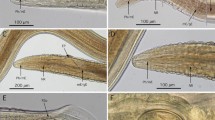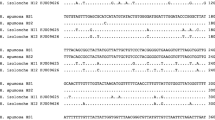Abstract
Background
Rodentolepis nana (syn. Hymenolepis nana), the most common cyclophyllid tapeworm infecting rodents, is a well-studied gastrointestinal parasite in mice and belongs to the family Hymenolepididae.
Methods
The present study focuses on the molecular analysis for the nuclear genes (ITS-1, 18 S, and 28 S rDNA) used for the accurate recognition of the recovered Rodentolepis species.
Results
The annotated partial ITS-1, 18 S, and 28 S rDNA gene regions were deposited in GenBank (gbǀ MW310394.1, gbǀ MW327585.1, and gbǀ MW324479.1, respectively) and further used in the maximum likelihood method (ML) to clarify their genetic relationships at the species level. The interrogation sequence of R. nana was aligned and belonged to the family Hymenolepididae, in the same group as all Hymenolepis species, which were distinct from Cyclophyllidea cestodes, especially species belonging to Anoplocephalidae and Taeniidae. Sequence data support the paraphyly of Hymenolepis species.
Conclusions
The phylogeny supports the availability of the ITS-1, 18 S, and 28 S rDNA genes as reliable genetic markers for evolutionary relationships.



Similar content being viewed by others
Data availability
All data generated or analyzed as part of this study are included in this published article.
References
Georgiev BB (2003) Cestoda (Tapeworms). In: (In: Thoney DA (ed) Schlager) Lower Metazoans and Lesser Deuterostomes. Grzimek's Animal Life Encyclopedia, vol 1, 2nd edn. Gale, Detroit
Ariola V (1899) II gen. Scyphocephalus Rigg. E proposta di una nuova classificazione dei cestodi. Atti Soc Ligust Sci Nat Geogr 10:160–167
Mariaux J, Tkach VV, Vasileva GP, Waeschenbach A, Beveridge I, Dimitrova YD, Haukisalmi V, Greiman SE, Littlewood DTJ, Makarikov AA, Phillips AJ, Razafiarisolo T, Widmer V, Georgiev BB (2017) Cyclophyllidea van Beneden in Braun, 1900. In: In: Caira JN, Jensen K (eds) Planetary Biodiversity Inventory (2008–2017): Tapeworms from Vertebrate Bowels of the Earth. University of Kansas, Natural History Museum, Lawrence
Weinland DF (1858) Human cestoides. An essay on the tapeworms of man. Metcalf & Co, Cambridge, p 93
Sulima A, Savijoki K, Bien J, Näreaho A, Salamatin R, Conn DB, Mlocicki D (2018) Comparative proteomic analysis of Hymenolepis diminuta cysticercoid and adult stages. Front Microbiol 8:2672
Willcocks B, McAuliffe GN, Baird RW (2015) Dwarf tapeworm (Hymenolepis nana): characteristics in the Northern Territory 2002-2013. Aust Paediatric J 51:982–987
Jarošová J, Šnábel V, Cavallero S, Chovancová Z, Antolová D (2020) The mouse bile duct tapeworm, Hymenolepis living small mammals in Slovakia: Occurrence and genetic analysis. Helminthologia 57:120–128
Thompson RC (2015) Neglected zoonotic helminthes Hymenolepis nana, Echinococcus canadensis and Ancylostoma ceylanicum. Clin Microbiol Infect 21:426–432
Gliga DS, Pisanu B, Walzer C, Desvars-Larrive A (2020) Helminths of urban rats in developed countries: a systematic review to identify research gaps. Helminthology 119:2383–2397
Foronda P, López-González M, Ferrer MH, Makarikov V, Feliu C (2011) Distribution and genetic variation of hymenolepidid cestodes in murid rodents on the Canary Islands (Spain). Parasit Vectors 4:185
Shahnazi M, Mehrizi MZ, Alizadeh SA, Heydarian P, Saraei M, Alipour M, Hajialilo E (2019) Molecular characterization of Hymenolepis nana based on nuclear rDNA ITS2 gene marker. Afr Health Sci 19:1–7
Gibson DI (1998) Nature and classification of parasitic helminths. In Topley and Wilsons: Microbiology and Microbial Infections, pp. 453-477. Edited by F. E. G. Cox, J. P. Kreier and D. Wakelin. London: Arnold. https://doi.org/10.1002/9780470688618.taw0192
Haukisalmi V, Hardman LM, Foronda P, Feliu C, Laakkonen J, Niemimaa J, Lehtonen JT, Henttonen H (2010) Systematic relationships of hymenolepidid cestodes of rodents and shrews inferred from sequences of 28S ribosomal RNA. Zool Scripta 39:631–641
Tijjani M, Majid RA, Abdullahi SA, Unyah NZ (2020) Detection of rodent-borne parasitic pathogens of wild rats in Serdang, Slangor, Malaysia: A potential threat to human health. Int J Parasitol Parasites Wildl 11:174–182
Coleman AW (2003) ITS-2 is a double-edged tool for eukaryotic evolutionary comparisons. Trends Genet 19:370–375
Waeschenbach A, Webster BL, Bray RA, Littlewood DTJ (2007) Added resolution among ordinal level relationships of tapeworms (Platyhelminthes: Cestoda) with complete small and large subunit nuclear ribosomal RNA genes. Mol Phylogenet Evol 45:311–325
Al-Olayan E, Elamin M, Alshehri E, Aloufi A, Alanazi Z, Almayouf M, Bakr L, Abdel-Gaber R (2020) Morphological, molecular, and pathological appraisal of Hymenolepis nana (Hymenolepididae) infecting Laboratory mice (Mus musculus). Microsc Microanal 26:348–362
Baehellerie J-P, Qu L-H (1993) Ribosomal RNA probes for detection and identification of species. In: In: Hyde JE (ed) Protocols in molecular parasitology. Humana Press, New Jersey
Littlewood DTJ, Olson PD (2001) Small subunit rDNA and the phylum Platyhelminthes: signal, noise, conflict and compromise. In: In: Littlewood DTJ, Bray RA (eds) Interrelationships of the Platyhelminthes. Taylor & Francis, London
Littlewood DTJ, Waeschenbach A, Nikolov PN (2008) In search of mitochondrial marker for resolving the phylogeny of cyclophyllidean tapeworms (Platyhelminths, Cestode) – a test study with Davaineidae. Acta Parasitol 53:133–144
Thompson JD, Higgins DG, Gibson TJ (1994) CLUSTALW: improving the sensitivity of progressive multiple sequence alignment through sequence weighting, position-specific gap penalties and weight matrix choice. Nucleic Acids Res 22:4673–4680
Hall TA (1999) BioEdit: a user-friendly biological sequence alignment editor and analysis program for windows 95/98/NT. Nucleic Acids Symp Ser 41:95–98
Kumar S, Stecher G, Tamura K (2016) MEGA7: Molecular Evolutionary Genetics Analysis version 7.0. Mol Biol Evol 33:1870–1874
Tamura K, Nei M (1993) Estimation of the number of nucleotide substitutions in the control region of mitochondrial DNA in humans and chimpanzees. Mol Biol Evol 10:512–526
Rokni M (2008) The present status of human helminthic diseases in Iran. Ann Trop Med Parasitol 102:283–295
Král’ová I, Špakulová M (1996) Interspecific variability of Proteocephalidae exiguus La Rue, 1911 (Cestoda: Proteocephalidae) as studied by the random amplified polymorphic DNA method (RAPD). Parasitol Res 82:542–545
Zhu XQ, Amelio SD, Gasser RB, Yang TB, Paggi L, He F, Lin RQ, Song HQ, Ai L, Li AX (2007) Practical PCR tools for the delineation of Contracaecum rudolphii A and Contracaecum rudolphii B (Ascaridoidea: Anisakidae) using genetic markers in nuclear ribosomal DNA. Mol Cell Probes 21:97–102
Macnish MG, Morgan-Ryan UM, Monis PT, Behnke JM, Thompson RCA (2002) A molecular phylogeny of nuclear and mitochondrial sequences in Hymenolepis nana (Cestoda) supports the existence of a cryptic species. Parasitology 125:567–575
Mariaux J (1998) A molecular phylogeny of the Eucestoda. J Parasitol 84:114–124
Hoberg EP, Mariaux J, Brooks DR (2001) Phylogeny among orders of the Eucestoda (Cercomeromorphae): Integrating morphology, molecules and total evidence. In: In: Littlewood DJT, Bray RA (eds) Interrelationships of the Platyhelminthes. Taylor & Francis, London, pp 112–126
Al-Quraishy S, Abdel-Gaber R, Alajmi R, Dkhil MA, Al-Jawher M, Morsy K (2019) Morphological and molecular appraisal of cyclophyllidean cestoda parasite Raillietina saudiae sp. nov. infecting the domestic pigeon Columba livia domestica and its role as a bio-indicator for environmental quality. Parasitol Inter 71:59–72
Nickisch-Rosenegk M, Lucius R, Loosfrank B (1999) Contribution to the Phylogeny of the Cyclophyllidea (Cestoda) inferred from mitochondrial 12S rDNA. J Mol Evol 48:586–596
Sharma S, Lyngdoh D, Roy B, Tandon V (2016) Differential diagnosis and molecular characterization of Hymenolepis nana and Hymenolepis diminuta (Cestoda: Cyclophyllidea: Hymenolepididae) based on nuclear rDNA ITS2 gene marker. Parasitol Res 115:4293–4298
Jarošová J, Antolová D, Šnábel V, Miklisová D, Cavallero S (2020) The dwarf tapeworm Hymenolepis nana in pet rodents in Slovakia – epidemiological survey and genetic analysis. Parasitol Res 119:519–527
Ito A, Onitake K, Andreassen J (1988) Lumen phase-specific cross-immunity between Hymenolepis microstoma and H. nana in mice. Inter J Parasitol 18:1019–1027
Nkouawa A, Haukisalmi V, Li T, Nakao M, Lavikainen A, Chen X, Henttonen H, Ito A (2016) Cryptic diversity in hymenolepidid tapeworms infecting humans. Parasitol Inter 65:83–86
Mirjalali H, Kia EB, Kamranrashani B, Hajjaran H, Sharifdini M (2015) Molecular analysis of isolates of the cestoda Rodentolepis nana from the great gerbil, Rhombomys opimus. J Helminthol 90:1–4
Acknowledgements
This study was supported by the Researchers Supporting Project Number (RSP-2021/25), King Saud University, Riyadh, Saudi Arabia.
Author information
Authors and Affiliations
Corresponding author
Ethics declarations
Conflict of interest
The authors have no conflict of interest related to the content of this article.
Additional information
Publisher’s Note
Springer Nature remains neutral with regard to jurisdictional claims in published maps and institutional affiliations.
Rights and permissions
About this article
Cite this article
Al-Amri, O., Al-Quraishy, S., Al-Shaebi, E.M. et al. Molecular identification of the rodent-borne pathogen Rodentolepis nana using the genetic markers of ITS-1, 18 S, and 28 S rDNA. Mol Biol Rep 49, 1361–1367 (2022). https://doi.org/10.1007/s11033-021-06966-x
Received:
Accepted:
Published:
Issue Date:
DOI: https://doi.org/10.1007/s11033-021-06966-x




